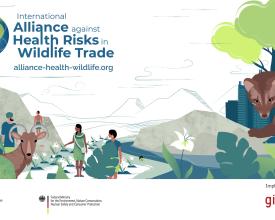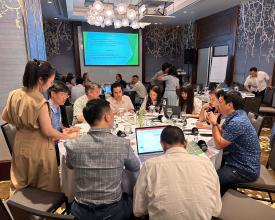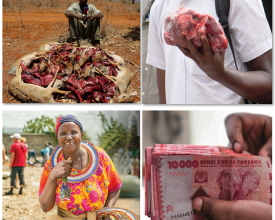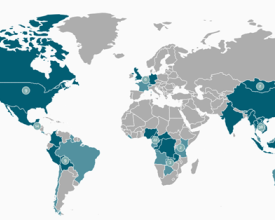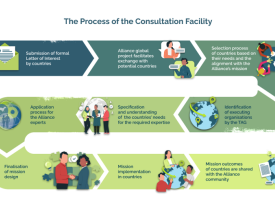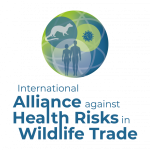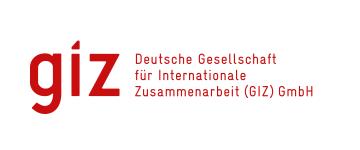
Alliance internationale contre les risques sanitaires liés au commerce des espèces sauvages
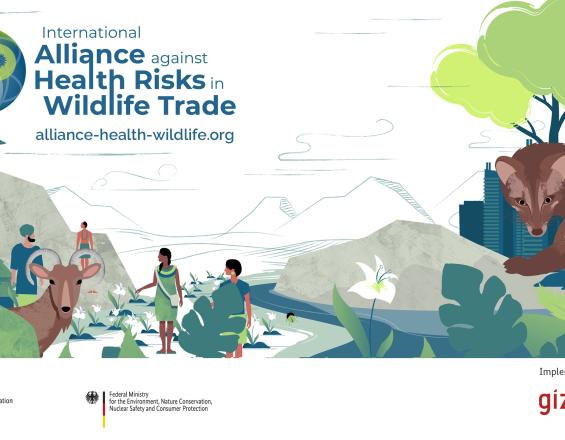
Avec l'augmentation de l'activité humaine mondiale qui empiète sur les habitats des espèces sauvages, la demande croissante de consommation d'espèces sauvages et l'expansion du commerce mondial, le risque de propagation d'agents pathogènes des espèces sauvages à l'homme s'accroît. Il n'y a pas de réponse simple à cette question et personne ne peut y parvenir seul. La seule chance que nous ayons est de travailler ensemble à la réalisation de cet objectif commun en adoptant une approche holistique, transversale et synergique.
L' Alliance internationale offre donc une solution en servant de plateforme inclusive et interdisciplinaire pour les parties prenantes. Il s'agit d'un espace de collaboration permettant d'unir les forces pour mieux comprendre et réduire la menace de propagation des agents pathogènes provenant du commerce et de la consommation d'espèces sauvages, en fournissant et en communiquant des données probantes et en soutenant les interventions. Nous réduisons ainsi les risques tout en améliorant la santé, l'équité et le bien-être de toutes les espèces grâce à une approche "One Health".
Contexte
Défis à relever
En raison de l'expansion de la civilisation et de l'augmentation de la consommation d'animaux sauvages, le contact entre la faune et l'homme devient encore plus étroit et le risque de propagation d'agents pathogènes à partir du commerce et des marchés d'animaux sauvages est donc fortement accru. L'absence de réglementation et le manque de données sur les tendances de la vente au détail posent un défi particulier à cet égard.
La traduction des informations en actions ne suit pas le rythme sans précédent des changements sociaux et environnementaux qui entraînent des risques sanitaires existentiels, des pandémies mondiales aux maladies familiales locales. Cela est dû au fait que les parties prenantes travaillent en vase clos et que les connaissances restent déconnectées les unes des autres. L'Alliance internationale aide les décideurs à agir plus rapidement et à prévenir les pandémies directement à leur source. Elle soutient les interventions de ses membres pour mieux comprendre et réduire la menace des retombées futures, afin d'améliorer la santé, l'équité et le bien-être de toutes les espèces.
Emplacement
Traiter
Résumé du processus
L'Alliance internationale est une plateforme diversifiée et multipartite qui comporte plusieurs éléments clés : un site web riche en fonctionnalités, des projets financés, des dossiers par pays et une structure gouvernementale. Les membres et la gestion de la communication jouent un rôle essentiel dans ce contexte.
En février 2024, notre communauté mondiale se compose de plus de 120 organisations politiques, universitaires et de la société civile nationales et internationales, ainsi que de plus de 90 scientifiques, experts et universitaires (soit un total de plus de 415 personnes).
Le site web sert de plaque tournante pour explorer le concept de l'Alliance , présenter le soutien des membres, partager des informations avec le public et la communauté, et faciliter l'échange de connaissances et d'expériences. La carte des projets et l'espace membres sont des outils particulièrement précieux pour atteindre ces objectifs.
Les groupes de travail impliquent activement les membres dans le développement de l'Alliance , en tirant parti de l'expertise de la communauté pour créer des résultats collectifs.
L'Alliance offre son soutien en finançant des projets, des paquets nationaux et des structures gouvernementales pour promouvoir les meilleures pratiques et traiter les risques sanitaires liés au commerce et à la consommation d'espèces sauvages. Cela permet aux parties prenantes de développer des solutions adaptées à leur contexte.
Blocs de construction
Carte du projet
La carte des projets sert d'outil sur notre site web pour une meilleure visibilité et visualisation des projets mis en œuvre par les organisations membres de l'Alliance internationale: à la fois des projets financés par l'Alliance et des projets gérés indépendamment par les membres de l'Alliance.
En tant que plateforme interdisciplinaire et inclusive rassemblant différentes disciplines, l'Alliance invite les efforts sur un large éventail de sujets liés au travail et aux objectifs de l'Alliance à être présentés sur cette carte de projets, afin que d'autres puissent les voir et s'y connecter.
Facteurs favorables
- la volonté des organisations membres de montrer et de présenter leurs projets
- la maintenance du site web
Leçon apprise
Afin d'inciter les autres membres à présenter leurs projets, vous devez disposer d'une collection existante de projets à présenter au début.
Ressources
Projets financés
À la suite de deux appels de fonds, 17 projets ont été sélectionnés. Ces projets représentent un large éventail d'approches et d'idées de solutions pour atteindre les objectifs de l'Alliance, en fonction du contexte.
Afin d'accroître la visibilité des projets et de favoriser l'échange de connaissances, ils sont invités à présenter leurs travaux en cours, leurs objectifs intermédiaires et leurs résultats préliminaires à la communauté de l'Alliance par le biais de messages sur le site web ou lors d'événements en ligne.
Facteurs favorables
Un financement suffisant est nécessaire pour assurer un soutien à long terme et une mise en œuvre durable des objectifs du projet.
Une communication continue entre les responsables du projet et le secrétariat de l'Alliance garantit la réussite du projet, la transmission des résultats à la communauté et, par conséquent, une valeur ajoutée pour cette dernière.
Leçon apprise
Un retour d'information adéquat de la part des partenaires du projet peut s'avérer difficile et nécessite de bonnes stratégies de communication.
Ressources
Paquets pays
L'objectif est d'établir des pratiques, des règles et/ou des normes pour réduire les risques pour l'environnement, la santé humaine et animale dans le commerce des animaux sauvages et des produits d'origine animale dans des pays partenaires sélectionnés dans les régions où la biodiversité est la plus importante. Il s'agit notamment de promouvoir l'évaluation des risques, la conception de mesures éducatives sous différentes formes (campagnes numériques et non numériques, cours de formation, etc.) et le suivi scientifique de la mise en œuvre des bonnes pratiques (par exemple, les évaluations d'impact). L'Alliance rassemble les acteurs concernés dans tous les secteurs et utilise les résultats concrets pour formuler des réglementations adaptées ou soutenir l'institutionnalisation de pratiques pertinentes.
Facteurs favorables
Les structures politiques et de la GIZ existantes, ainsi que les autres organisations partenaires locales dans le pays partenaire sélectionné.
Leçon apprise
En fonction de la situation initiale dans les pays partenaires, il faut commencer à différents niveaux. Dans certains cas, il est possible de travailler ensemble au niveau politique, dans d'autres, il est plus efficace de mettre en œuvre les objectifs par l'intermédiaire d'une organisation partenaire qui possède déjà une expérience sur place et un réseau d'acteurs locaux.
Ressources
Espace membres
L'espace membres est réservé aux membres enregistrés (individus ou organisations) de l'Alliance. L'adhésion est gratuite et vous donne la possibilité d'unir vos forces pour une cause commune ainsi que de vous connecter, de collaborer et d'établir des partenariats avec d'autres membres.
L'espace membres sert de plateforme d'échange interne, de partage d'articles intéressants, d'offres d'emploi et de dates d'événements, ainsi que d'accès à des enregistrements vidéo d'événements passés sur demande.
Facteurs favorables
- la maintenance du site web et de l'espace membres
- il a besoin de membres motivés et engagés qui sont prêts à participer activement à la plateforme
Leçon apprise
Au début de la mise en œuvre, un contact direct et régulier avec les membres est nécessaire pour les encourager à publier des messages et à interagir les uns avec les autres. Des demandes directes par courrier électronique ou des rappels dans le bulletin d'information peuvent être utiles. Un soutien actif du secrétariat est nécessaire au départ, mais il peut être réduit au fil du temps.
Ressources
Groupes de travail
L'Alliance internationale compte actuellement trois groupes de travail, qui sont dirigés par les membres eux-mêmes et bénéficient du soutien du secrétariat de l'Alliance . Chaque groupe de travail est dirigé par un ou deux présidents et le groupe se réunit toutes les 6 à 8 semaines pour assurer un processus de travail continu.
Nous avons actuellement les groupes de travail suivants :
- Interface science-politique (présidente : Sue Liebermann, WCS)
Compte tenu de notre compréhension fondamentale de la faune et de la flore sauvages, nous voulons insuffler cette compréhension, basée sur des preuves scientifiques, dans les processus politiques internationaux.
- Changement de système transformatif : La vue d'ensemble (président : Alex D. Greenwood, IZW Berlin ; Barabara Maas, NABU)
Il existe des obstacles fondamentaux sous-jacents à la réalisation des objectifs et des buts des alliances. Ce groupe de travail se concentre sur l'identification et la résolution de ces obstacles.
- Évaluation/interventions efficaces (président : Craig Stephen, One Health Consultant)
L'objectif est de rassembler les bonnes pratiques des membres de l'Alliance en matière d'interventions efficaces afin de permettre l'apprentissage et l'échange de connaissances entre les secteurs et les régions.
Facteurs favorables
Le succès du groupe de travail dépend de la formulation d'objectifs clairs, de l'engagement et de l'organisation de la présidence, de la motivation des membres du groupe et de l'existence d'un flux de travail continu.
Leçon apprise
Étant donné que la plupart des membres ont déjà des emplois à temps plein très exigeants, la capacité temporelle de chacun d'entre eux peut changer au fil du temps. Il peut être difficile d'assurer un bon déroulement des opérations et une bonne atmosphère de travail. L'appréciation et la compréhension sont d'une grande importance pour permettre la poursuite de la collaboration.
Ressources
Dispositif de consultation gouvernementale
L'objectif du dispositif de consultation est de fournir des services de conseil multidisciplinaires spécifiques au contexte, assurés par des experts de l'Alliance , aux gouvernements/institutions gouvernementales des pays présentant un risque élevé de nouvelles maladies d'origine zoonotique, afin de prévenir les infections par contagion.
L'expertise de plus de 180 organisations membres et experts individuels de l'Alliance sera utilisée pour constituer ces équipes interdisciplinaires.
Le dispositif de consultation est spécialisé dans les services consultatifs gouvernementaux à moyen terme, de prévention primaire et spécifiques au contexte, avec des résultats concrets dans le contexte des risques sanitaires liés au commerce et à la consommation d'espèces sauvages tout au long de la chaîne de contact et de commerce.
Facteurs favorables
Une consultation efficace et durable nécessite une analyse approfondie des politiques afin d'identifier les gouvernements adéquats.
L'action politique existante ou d'autres réglementations politiques concernant l'intersection de la faune sauvage et de la santé humaine, par exemple, sont particulièrement utiles au début de la consultation.
Leçon apprise
La facilité a été lancée en décembre 2023. C'est pourquoi les enseignements tirés ne seront communiqués que dans le courant de l'année 2024.
Ressources
Impacts
Nous avons créé une plateforme multipartite interdisciplinaire, internationale et inclusive avec un espace où les différentes parties prenantes se rencontrent, échangent et travaillent en synergie par le biais de la lettre d'information, des séminaires, des ateliers, des discussions d'experts et des groupes de travail. Pour traduire les connaissances et la science en changements réels, nos membres travaillent ensemble sur des sujets spécifiques tels que l'interface science-politique, le changement de système transformatif, ou l'évaluation et les interventions efficaces.
Nous avons soutenu l'expérimentation de diverses approches de la prévention primaire des pandémies et touchons actuellement plus de 600 personnes par le biais de notre seule lettre d'information.
Nous élaborons des recommandations politiques spécifiques au contexte, nous sensibilisons le public et, par conséquent, nous modifions les comportements et nous comblons les lacunes en matière de connaissances.
Nous collaborons avec les gouvernements, les ministères et le secteur de la santé publique par l'intermédiaire d'un mécanisme de consultation gouvernemental afin de garantir que les connaissances fondées sur des données probantes parviennent aux décideurs.
Nous préparons le terrain pour fournir aux parties prenantes les connaissances nécessaires sur les risques sanitaires liés au commerce des espèces sauvages, afin qu'elles puissent agir en connaissance de cause et réduire les risques d'épidémies et de pandémies à l'avenir.
Nous avons placé le sujet dans des forums de haut niveau et contribué à façonner les processus internationaux (CDB, CITES, instrument de lutte contre les pandémies, GDG, ...). En conséquence, nous avons considérablement accru la visibilité de l'Alliance et assuré la poursuite de son travail.
Bénéficiaires
- Population humaine mondiale, réduction du risque de crises sanitaires et économiques dues à la propagation des zoonoses grâce à la prévention des pandémies
- la faune et la flore sauvages, leur santé et leur conservation
- L'environnement grâce à une meilleure compréhension de ses liens avec l'homme et l'animal

